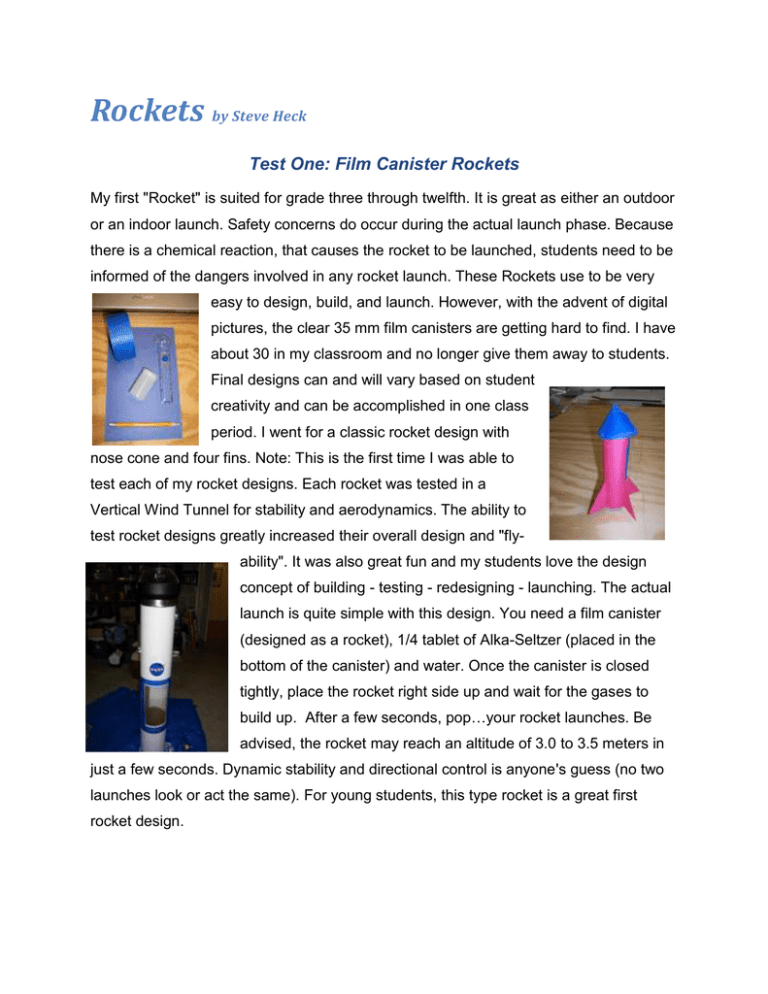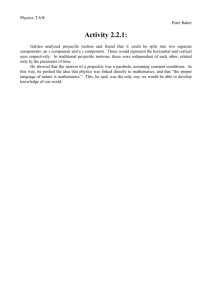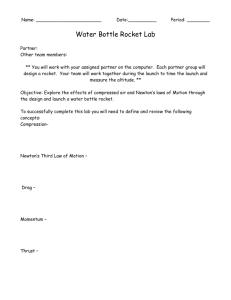Rockets - Milford-NASA
advertisement

Rockets by Steve Heck Test One: Film Canister Rockets My first "Rocket" is suited for grade three through twelfth. It is great as either an outdoor or an indoor launch. Safety concerns do occur during the actual launch phase. Because there is a chemical reaction, that causes the rocket to be launched, students need to be informed of the dangers involved in any rocket launch. These Rockets use to be very easy to design, build, and launch. However, with the advent of digital pictures, the clear 35 mm film canisters are getting hard to find. I have about 30 in my classroom and no longer give them away to students. Final designs can and will vary based on student creativity and can be accomplished in one class period. I went for a classic rocket design with nose cone and four fins. Note: This is the first time I was able to test each of my rocket designs. Each rocket was tested in a Vertical Wind Tunnel for stability and aerodynamics. The ability to test rocket designs greatly increased their overall design and "flyability". It was also great fun and my students love the design concept of building - testing - redesigning - launching. The actual launch is quite simple with this design. You need a film canister (designed as a rocket), 1/4 tablet of Alka-Seltzer (placed in the bottom of the canister) and water. Once the canister is closed tightly, place the rocket right side up and wait for the gases to build up. After a few seconds, pop…your rocket launches. Be advised, the rocket may reach an altitude of 3.0 to 3.5 meters in just a few seconds. Dynamic stability and directional control is anyone's guess (no two launches look or act the same). For young students, this type rocket is a great first rocket design. Test Two: Foam Rockets My second test rocket is of a foam rocket design. I found this type of rocket to be for more advanced rocket designers. I would recommend it for mid-school and high school students. I built and then tested three different models of both size and shape. By using a foam rocket design, it is easy to create different models. Many designs are available from the NASA Rocket Educator's guide or from the Civil Air Patrol Rocket Guides. I chose a Goddard Rocket, a space shuttle, and a hybrid design with winglets to increase stability. Each was easily constructed using foam insulation piping and Styrofoam plates for wings or fins. Hot glue is used to secure the wings or fins to the body and care must be taken due to the extreme heat. I then placed each model into my wind tunnel. In doing so, I was able to compare their flight characteristic and overall aerodynamics. This enabled me to decide on which foam rocket would be best to launch. I found this type of rocket to be the easiest to launch. A wide variety of launch angles allows for a variety of launch paths for greater height and distance. The shuttle model flew the highest, farthest, and had the most dynamic stability of the three. I developed a five to seven day Design Process Lesson/ lab for my students using these rockets. Students are very excited to share their creative designs and discuss why they chose the design. Test Three: Two Liter Water Rockets My final test rocket was of a water rocket design using two-liter bottles. Of the three types of rockets tested, this is the most dangerous for students due to the high pressures at launch and the altitudes they can reach. Great video at: http://www.plans4fun.com/water_rocket.htm A safety or launch zone area must be established for students. These types of rockets are best suited for the upper grade levels, middle school or high school. There are numerous websites available for students to research and obtain design concepts for these rockets. Some designs include multi-stage rocket that reach great heights. NASA has an excellent applet at http://www.grc.nasa.gov/WWW/K-12/rocket/rktsim.html to help student design and test their rockets. Based on this testing, I selected a basic design and used paper rolls as a fin design. These types of fins reduced my rocket's wobble in the wind tunnel test. It proved to be a very stable rocket design. Its flight characteristics and dynamic stability made it fun to launch. To launch these rockets, one needs a special high-pressure launch system. NASA has designs for constructing one in the NASA Rocket's Educator Guide or they can be purchased commercially. Of the three rockets tested, my water rocket obtained the greatest height, that of over 100 meters. Students also like the idea of getting wet and watching other students get wet during the launch phase. This is a great rocket for summer field days at schools. Flight Data: Three launches were accomplished for each rocket type. Film Canister Rocket: Fuel component: Mixture of Alka-Seltzer tablet (1/4) and Water (1/2 filled canister). Fight altitude and duration: 3.0 meters and 5.5 seconds from launch to landing Flight Path: 90 degrees from launch and effected by wind. (45 degrees measurement with Astrolabe (launch altitude tracker - tangent A) Velocity: 3.0 m divide by 2.5 seconds = 1.2 m/s (to apogee) Acceleration: 1.2 m/s divide by 2.5 second = 0.48 m/s/s Note: Time to launch after fueling is uncertain and unpredictable. Foam Rocket: Fuel component: Rubber bands Fight altitude and duration: 93 meters and 12 seconds (from launch to landing) Flight Path: Selected 45 degrees from launch and little effect by the wind. Velocity: 93.0 m divide by 12.0 sec. = 7.7 m/s (total flight time due to angle of launch) Acceleration: 7.7 m/s divided by 12.0 seconds = 0.64 m/s/s Note: Great horizontal flight time and distance (45-degree launch) Two-Liter Water Rocket: Fuel component: Water and Compressed Air (55 psi) Fight altitude and duration: 105 meters and 22 seconds from (launch to landing) Flight Path: 90 degrees from launch and effected by wind. (45 degrees measurement with Astrolabe (launch altitude tracker - tangent A) Velocity: 105 m divide by 10 seconds = 10.5 m/s (to apogee) Acceleration: 10.5 m/s divided by 10 seconds = 1.05 m/s/s (to apogee) Note: Extremely fast acceleration to altitude (apogee) under very high pressure. Physical Laws and Aerodynamics: Film Canister Rocket: Easily demonstrates Newton's Three Laws of motion to students. 1) Law of Inertia: Canister does not move until chemical reaction (engine fires). Thrust increases causing canister to rise (launch). Net force is a positive upward movement. Velocity increase until fuel is spent and gravity acts on canister 2) F = m x a: The chemical reaction (fuel) gives the power or force (change in mass times velocity) required to accelerate the mass of the canister thus causing lift off or launch. 3) Action - Reaction: The canisters engine (chemical reaction) pushed against the concrete forcing a reaction or the canisters launch Easily demonstrated "Aerodynamics Principles" during testing and flight: 1) Wind tunnel and fight testing showed excellent static (resting) and dynamic (movement) stability. No problems noted during flight. 2) Design ensured no tumbling of rocket and a constant acceleration until apogee and return to ground. Foam Rocket: Student or Teacher demonstration of Newton's Three Laws of motion. 1) Law of Inertia: Until you put back on the string to activate the rubber band, the Rocket is at rest. Once released, the Rocket increases its "thrust" causing it to rise (launch). Like the Canister, the "Net Force" is a positive vertical and horizontal movement. Velocity increase until gravity acts on the Rocket and it glides back to earth (much like the shuttle). 2) F = m x a: The tightening or pulling of the rubber band gives the rocket power or force. This action is required to accelerate the mass of the Foam Rocket thus causing flight. 3) Action - Reaction: Pulling the Foam Rocket's sting in one direction will cause the Rocket to fly or launch in the other direction once released. The farther the pulling action in one direction, the greater the tension on the rubber band. Upon release an opposite and equal reaction occurs. Demonstrated Aerodynamics: 1) The design of this Foam Rocket mirrors NASA's shuttles. It had an excellent wind tunnel and fight tests. The rocket showed good static or resting stability. Further, this rocket excellence in dynamic stability making it fun to fly. 2) This design (shuttle) in the wind tunnel showed great equilibrium of flight characteristic. During actual fight, it flew and glided back to earth just like the shuttle (very smooth). It covered a great distance with ease. Two Liter-Water Rocket: A Teacher only demonstration of Newton's Three Laws of motion. 1) Law of Inertia: Like the Canister Rocket, the Two-Liter Water Rocket does not move until its engine fires (high air pressure release of the water). Its thrust will increases rapidly causing Water Rocket to rise (launch). A positive Net Force results in a rapid upward movement. The rockets Velocity will continue to increase until all of its fuel is spent and gravity acts on it and returns it to Earth. 2) F = m x a: The fuel (high air pressure and water) gives the Water Rocket the power or the force (a change in its mass times its velocity) required to accelerate its mass causing it to lift off or launch. 3) Action - Reaction: A great display of action-reaction. The Water Rocket's engine pushed against the ground forcing a reaction or the launch. The trail of water leaving the rocket under high air pressure is visible throughout the launch Demonstrated Aerodynamics: 1) Wind tunnel testing showed the circular fins to be a stabilizing addition. As a result, the large two-liter bottle was very stable throughout testing. This was true in flight , as the rocket went straight up and did not turn or rotate in flight. It showed excellent flight characteristics and both excellent static (resting on launch pad) and dynamic or flight movement stability. 2) The Rockets unique fin design ensured no tumbling or turning of rocket. Further, it had a rapid acceleration until apogee and return to ground.







